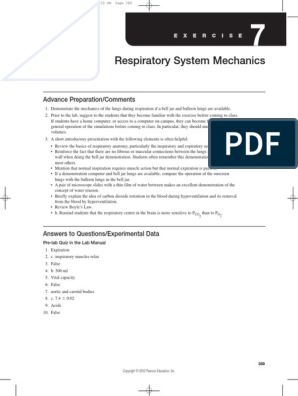0% found this document useful (0 votes)
109 views28 pagesRespiratory System & Spirometry Lab
The document appears to contain information from a respiratory system laboratory session involving examining respiratory structures, histology slides, and performing spirometry using a Biopac system. Key points include:
1) Students identified parts of the respiratory system from models and a fresh lung specimen and examined histology slides of the trachea and lung.
2) Lung volumes and capacities were measured using the Biopac L012 Pulmonary Function module, including tidal volume, inspiratory capacity, inspiratory reserve volume, and more.
3) Instructions were provided on performing specific inhalation and exhalation maneuvers and analyzing the resultant spirometry data to determine various respiratory measurements.
Uploaded by
Mâřâh MöHămmădCopyright
© © All Rights Reserved
We take content rights seriously. If you suspect this is your content, claim it here.
Available Formats
Download as PPTX, PDF, TXT or read online on Scribd
0% found this document useful (0 votes)
109 views28 pagesRespiratory System & Spirometry Lab
The document appears to contain information from a respiratory system laboratory session involving examining respiratory structures, histology slides, and performing spirometry using a Biopac system. Key points include:
1) Students identified parts of the respiratory system from models and a fresh lung specimen and examined histology slides of the trachea and lung.
2) Lung volumes and capacities were measured using the Biopac L012 Pulmonary Function module, including tidal volume, inspiratory capacity, inspiratory reserve volume, and more.
3) Instructions were provided on performing specific inhalation and exhalation maneuvers and analyzing the resultant spirometry data to determine various respiratory measurements.
Uploaded by
Mâřâh MöHămmădCopyright
© © All Rights Reserved
We take content rights seriously. If you suspect this is your content, claim it here.
Available Formats
Download as PPTX, PDF, TXT or read online on Scribd
/ 28






















































































